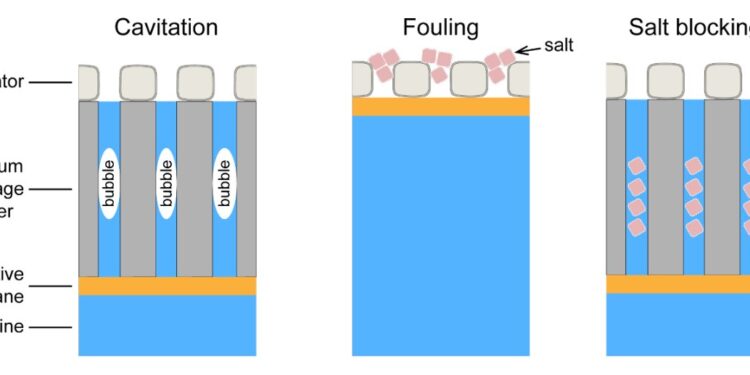The diagram illustrates the challenges of achieving stable lithium extraction using solar transpiration. There are three main difficulties: (i) on the left, the tension caused by transpiration puts the water in a metastable state, making it susceptible to cavitation, which hinders the transport of water with vapor bubbles; (ii) in the middle, the extracted salts can accumulate above the evaporator, thus reducing the absorption of sunlight and obstructing transpiration; (iii) True, the extracted salts can also accumulate in the channels of the storage layer, blocking the flow of water. Credit: Science (2024). DOI: 10.1126/science.adm7034
A team of engineers from Nanjing University, working with two colleagues from the University of California, Berkeley, have developed a new way to extract lithium from brackish water.
In their article published in the journal Sciencethe team describes the process they developed and the device they built and how it could be used to extract lithium from various natural sources. Seth Darling, from the Argonne National Laboratory in the United States, published a Perspective article in the same journal issue describing the work the team is doing in this new effort.
Lithium is in high demand due to its use in batteries. Unfortunately, its traditional sources, hard rock ores, are expected to decline in coming years. For this reason, scientists are looking for other sources such as the brackish water found in the world’s oceans. Previous research suggests there is more than enough to meet global demand for as long as needed.
The problem is extracting the lithium in a way that doesn’t pollute the environment and is relatively inexpensive to obtain. In this new effort, the research team developed an approach called solar transpiration-powered lithium extraction and storage (STLES).
The idea behind this new approach is to use sunlight to extract lithium from brine. This involves creating a floating device on the surface of the brine. Inside the device is an aluminum oxide membrane containing nanoparticles.
When the sun shines on the devices, pressure builds that forces the lithium through the membrane, separating the ions from the brine — a ceramic silica frit pierced with tiny holes that stores the lithium salts when they are removed. The researchers note that because the system works passively, it is very inexpensive. They also note that it can be used in places other than the ocean, such as the Dead Sea.
The new approach is not the only one to be studied. Another team from King Abdullah University of Science and Technology developed a technique that involves using iron-phosphate electrodes and silver/silver halide redox electrodes to extract lithium ions from the brine solution, which are then released into a fresh water compartment. They also published an article describing their technique in the journal Science.
More information:
Yan Song et al, Lithium extraction and storage powered by solar transpiration, Science (2024). DOI: 10.1126/science.adm7034
Seth B. Darling, The Brine of Time, Science (2024). DOI: 10.1126/science.ads3699
Zhen Li et al, Extraction of lithium from brine using a decoupled and membrane-free electrochemical cell design, Science (2024). DOI: 10.1126/science.adg8487
© 2024 Science X Network
Quote: Engineers develop solar extraction of lithium from brine (October 1, 2024) recovered October 1, 2024 from
This document is subject to copyright. Except for fair use for private study or research purposes, no part may be reproduced without written permission. The content is provided for informational purposes only.



